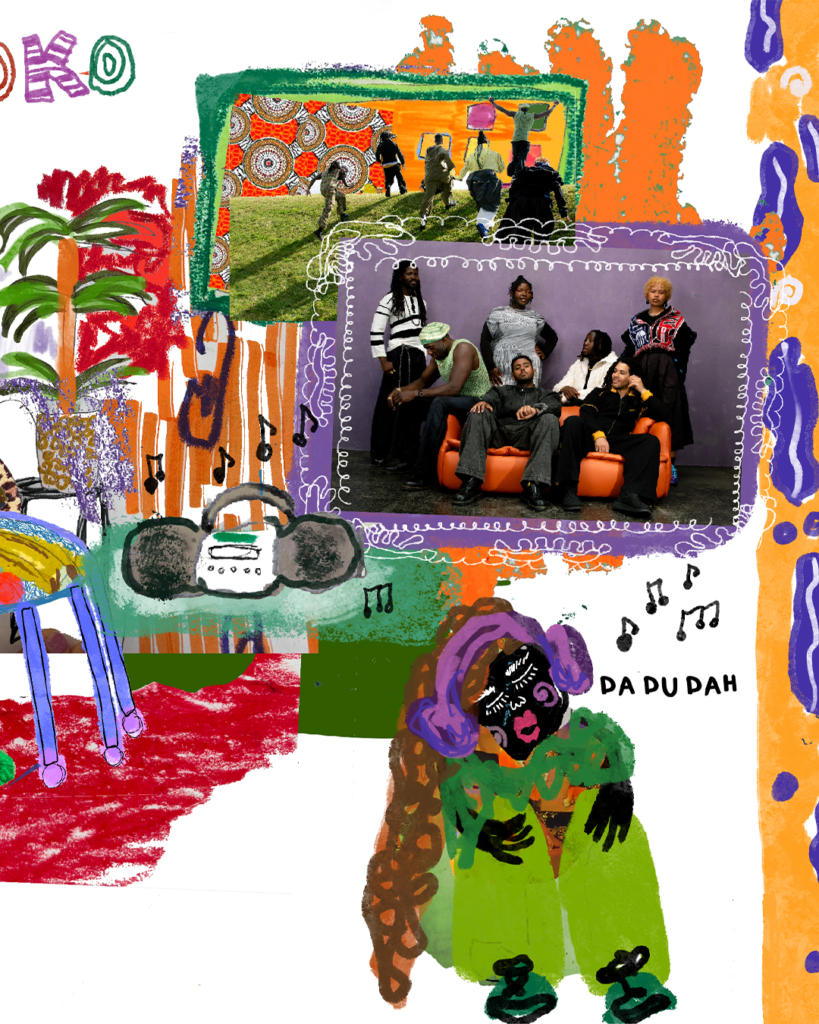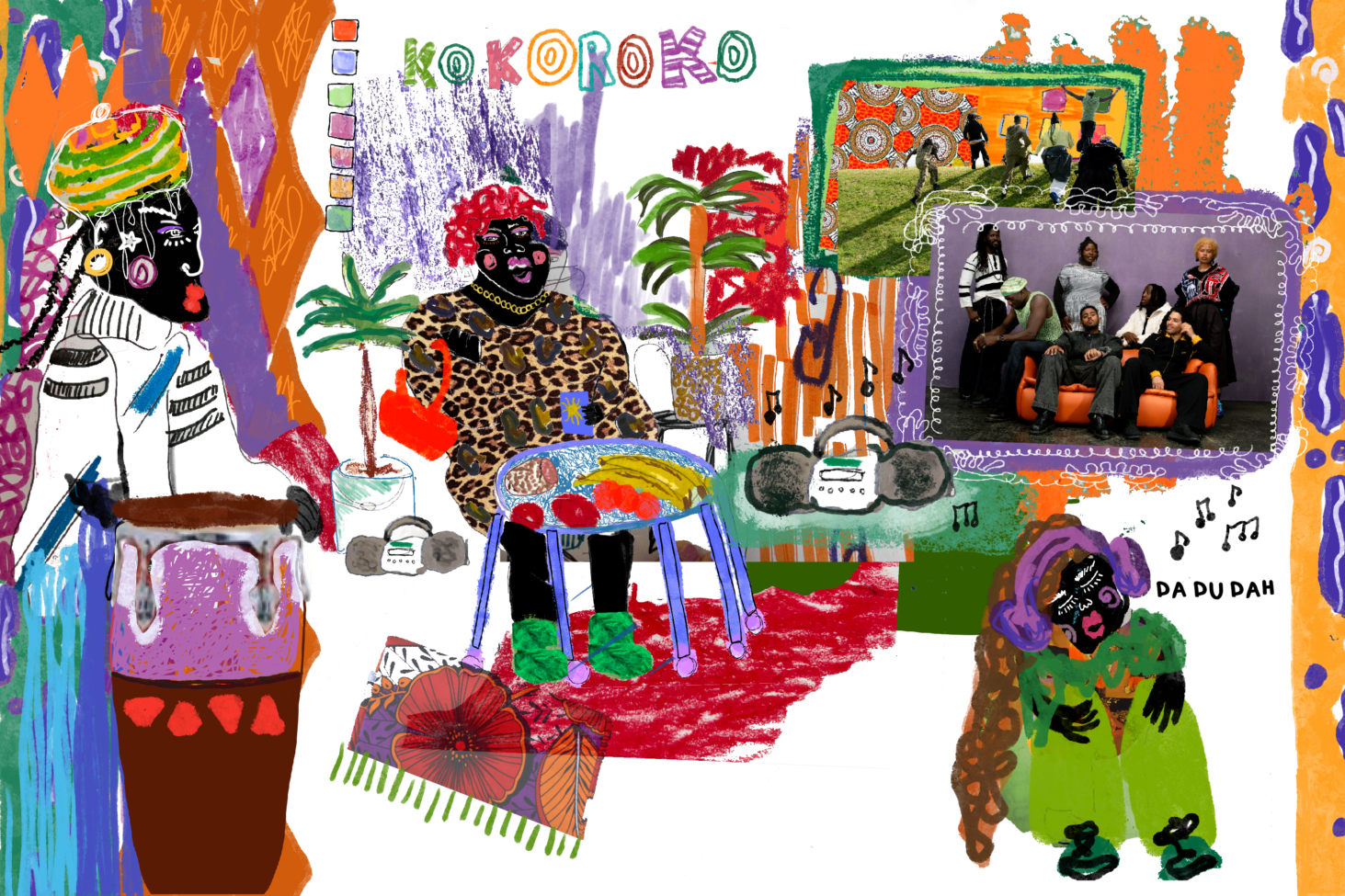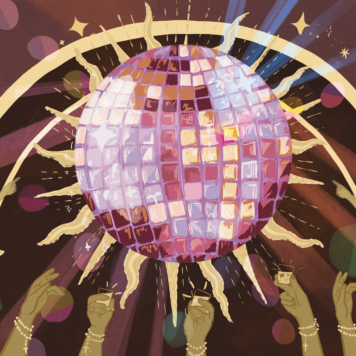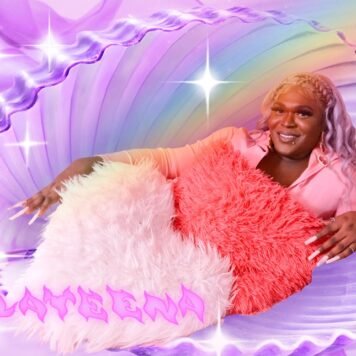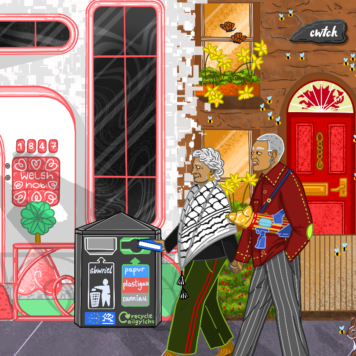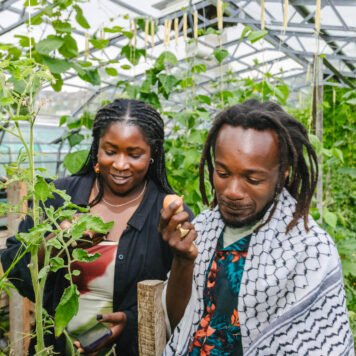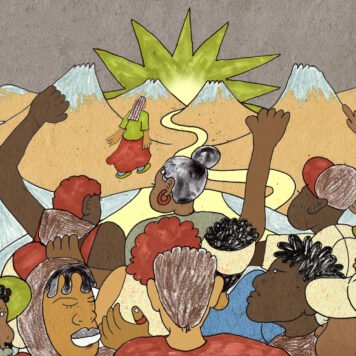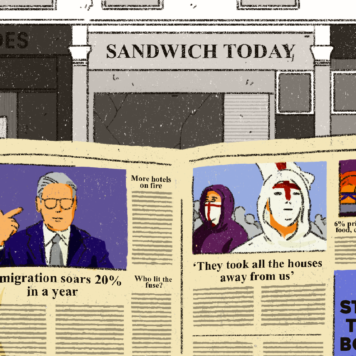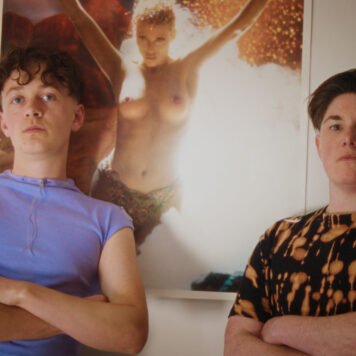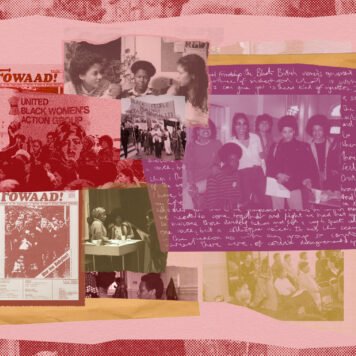It was a sweltering day in London when I sat down with Sheila Maurice-Grey and Ayo Salawu over Zoom. Both musical powerhouses, Sheila sings, plays the trumpet and flugelhorn, while Ayo plays the drums, in their band Kokoroko, a septuplet group bringing their own twist to highlife, funk, jazz and Afrobeat. I’ve been a huge fan since 2019 – so discussing their journey up to their latest album release ‘Tuff Times Never Last’ is an honour.
There’s nothing more I love than understanding what albums have shaped the artist, so I kick off finding out about theirs. For Sheila, it’s My Love and Music by Ebo Taylor and Hard Groove by The RH factor. Ayo nods in approval at Sheila’s choices before naming Lift Him Up by Ron Kenoly and Arthur Verocai’s self-titled album. I then ask which Kokoroko songs are closest to their heart: Sheila’s are ‘My Prayer’ and ‘My Father in Heaven’, and Ayo’s are ‘Something’s Going On’ and ‘Closer to Me’.
These choices become the foundation for our conversation – tracing Ayo and Sheila’s personal music journeys, their evolving relationship with sound, and Kokoroko’s path toward their latest album and headline show.
Echoes of home, rhythms of now
Music has always been central to both Sheila and Ayo’s upbringing. Ayo tells me he grew up in Nigeria, moving to the UK when he was 11 – so his musical roots are planted there. Church also played a pivotal role. “I was hearing a lot of rhythms that you would hear in Afrobeat or high life in the praise and worship in church,” he explains.
Combine this with moving to London and being further exposed to American music, reggae, lovers rock, jazz, soul, funk and disco music built an eclectic musical palette that has been brought to the music Kokoroko makes. Ayo especially credits bands like Earth Wind and Fire, and “all kinds of jazz – particularly Herbie Hancock,” for the band’s musical development.
“In London a lot of people are first or second generation,” he says. “So we’re closely connected to the music of Fela Kuti and Ebo Taylor. But being in the diaspora also means that we’re exposed to so much more.”
Being in London as a first or second generation migrant is a unique experience I deeply resonate with. Black British culture is around 70 years old, much of it marked by the arrival of Caribbean people being invited over by the UK to rebuild after WWII.
Being exposed to people who are still closely linked to their home countries brings opportunities for cultural blends and exchanges. We have seen this play out in Black British English lexicon, food, media – and music is no stranger to this either. Genres like Afroswing and Afro bashment are key examples. I find Kokoroko’s sound to be uniting for diasporans globally, but also reflective of the local influences a culturally rich city like London brings too.
Our lens, our sound: Kokoroko’s sonic journey
10 years ago, Sheila was in an Afrobeat band, and got talking to (her future bandmate and co-founder) Onome.
She remembers them both complaining about the state of the Afrobeat scene. “I feel like there were a lot of elders from different parts of Africa – and particularly West Africa – who were leading the bands, but then the rest of the band would be white. This exposed how much we needed to reclaim this space and retell the story through our lens.” Kokoroko was born shortly after.
Both Ayo and Sheila reflect on the importance of connecting to Black music. And the African diaspora and sounds from home are very central to Kokoroko’s sound and ethos, but they’re in no way a tribute band.
They tell me it took them a while to distinguish their sound from the greats of the past. “You can get bogged down with feeling pressured to follow these paths,” Sheila explains. “Of course, it’s good to know your history, but there’s this famous quote by Charlie Parker, which is: you need to master your instrument, and then you forget about it. So, I think it’s the same approach we’ve tried to take with making music.”
Thinking about their music this way has meant that they recognise that while these influences have laid the groundwork for their style, they aren’t limited to this. Rather, they set the stage for freedom of expression and experimentation, allowing influences from both home and the diaspora to enhance their different lanes of creativity, which they both proudly say is more present in this latest album.
Finding home in the music: growth, grief, and the joy of Black audiences
I was delighted to hear about their personal music journeys and influences, because I think our beginnings are so crucial to our current development.
Sheila is visibly shocked when I mention their band was formed in 2014. “It’s crazy! Because that was more than 10 years ago,” she exclaims. In the lead up to their first body of work, the group had already travelled to and played in Gambia, Brazil and Colombia. To be making such headway in connecting with your audiences is nothing short of incredible.
They both reflect on much they’ve grown sonically and physically. Despite feeling the newbie nerves, they produced a brilliant EP with their first hit single Abusey Junction – named after the real place in Gambia, where they wrote the track. Many fans, including myself, were introduced to them through this single and have been riding with them on the journey since.
The next stop in Kokoroko’s journey was their first album release: “Could We Be More?” Crediting their producer Miles James for symbiotically working with and sharpening their creative focus, this album’s process takes us to Eastbourne where the group formed much of this album.
The story they were trying to tell through this album was the recurring theme of ‘home’ – Baba Ayoola, for example, was dedicated to [Kokoroko’s sax player] Cassie’s grandfather.“Sometimes our homes are traumatic, Sheila says, “but I think it is very ingrained in humans to want a sense of belonging. To find that place of comfort.”
I thought this was incredibly beautiful. The idea that our sense of home can encompass a physical space, loss, grief, trauma, but also our origin story, our compass and sense of camaraderie is testament to how the human experience is about making a home in ourselves and others we hold dear and that we have the capacity to do this again even after experiencing hurt.
From meme to masterpiece: making ‘Tuff Times Never Last’
After reflecting on their highlights over the years, we got into the release of their latest album ‘Tuff Times Never Last’. I was curious as to whether it came from the famous lines of content creator Demi Demi who says “Tough times never last, only tough people last.”
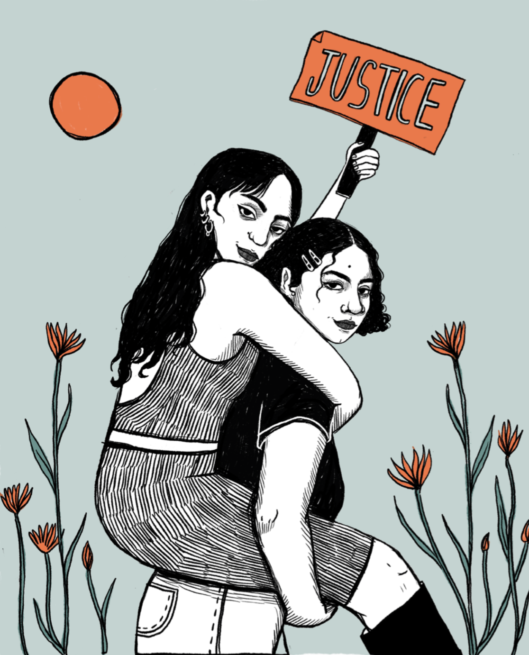
Join our mailing list
Sign up for shado's picks of the week! Dropping in your inbox every Friday, we share news from inside shado + out, plus job listings, event recommendations and actions ✊
Sign up for shado's picks of the week! Dropping in your inbox every Friday, we share news from inside shado + out, plus job listings, event recommendations and actions ✊
To my pleasant surprise, it was! “That meme definitely inspired it,” Ayo says. “It was one of those names that was being thrown around early on, sort of as a joke. But then, as we sat with it and looked at the other suggestions, we said – this one just slaps differently.”
Still flowing with the theme of Kokoroko situating themselves within Black culture, Ayo continues “we like the fact that it’s a bit of a cultural reference as well. We’re very big on culture. I think we all experience different kinds of seasons in our life. There’s always going to be ups and downs, but to have that hope that there is that other side to get to. We wanted to paint that sound world that reminds people that the other side is either there in that moment or is coming for you.”
With the name of the album feeling all the more fitting, I was keen to understand what the process of making this album was like. Kokoroko brought this album to life in the Middle Farm studio in Devon. “We really wanted this album to be a positive one – to bring light into the world,” Sheila explains. But it’s more than that. “Through bringing light, we explore many themes, including loss, friendship. love, both platonic and romantic.”
And light they have brought! Listening to this album made me so proud to be a Kokoroko fan. This album felt light, playful and groove inspiring. I was keen to know the songs they personally feel a connection to.
Both Ayo and Sheila name Sweetie as that. Ayo says: “I feel like Sweetie is one of those songs that you know as a banger. But you also know that other people are going to find it that way.” He is right, because this is one of my favourite songs. As a British Ghanaian, this song felt very close to Ghanaian Highlife, which resonated with me instantly.
Feel the feels, shake a leg
Speaking of spreading light in the world and music scene, we got onto their headline show happening in September at Brixton Academy. Both Ayo and Sheila light up with excitement.
“Brixton has such a thriving Black community and history,” Ayo says. “So, it always feels so special playing in these areas – where you feel like you can connect with your audience. Brixton’s always been a place where Kokoroko feels supported.”
Ayo and Sheila reeled off some of their most profound memories from Kokoroko’s journey: performances in Cape Town, Brazil, Colombia and the US. Something that felt monumental to them both was playing to majority Black audiences in all of those places. “You’d look out and see an audience of people who understood the music from a cultural standpoint,” Ayo explains. “People who were willing to move, and sing, and use their voices.”
Sheila wants to build more of that with their UK audiences. She admits that while the UK has a flourishing music scene, it’s predominately a white audience – and she’s saddened by how access to live music isn’t always accessible to Black people. It’s clear for Kokoroko that playing and sharing musical joy with Black people is the most pertinent reason for creating their music – and so playing this headline gig in Brixton feels fitting.
Of course, there are nerves involved – playing your biggest show to date is sure to rack these up – but what I hear from them both is an underlying readiness. It sounds like Kokoroko is right on time to do a show like this.
Participation is a huge aspect of a Kokoroko show, Sheila tells me. “I’m looking forward to hearing people sing along with us. It’s always a joyous moment when people can participate.” So: expect singing, dancing, live instrumentations and a transcendental dancefloor. This is truly a show for the people wanting to have fun, create memories and dance with like-minded strangers turned family.
Tuff Times Never Last, but Kokoroko’s groove does
One of the best things about music is how it becomes the soundtrack to our personal and collective transitions and milestones in life. We remember an album or song associated with grief, heartbreak, loss, but also deep celebration, a good summer’s day and a romantic meet-cute. This is something Sheila remarks on being one of the best things about Kokoroko’s music. “I love how our high tempo songs get everyone dancing and I love our slow songs that make people feel peaceful. We get to hear some beautiful stories from people experiencing life with our music.”
As our time drew to a close, I thought more about the beauty of live music bringing everyone together and how poignant the dancefloor feels. To end our conversation, I asked Ayo and Sheila what three words they hope people feel when listening to their album and attending their show, they said “Empowered, inspired and peace.”
You heard it here, if you’ve been looking for a moment for air while wading through the weary waters this world is currently under, have a listen to Tuff Times Never Last, and release your inhibitions at their headline show.
What can you do?
- Listen to Tuff Times Never Last by Kokoroko
- Listen to Could We Be More by Kokoroko
- Watch The Evolution of Black British Music on Netflix
- Listen to The complete-ish history of African Music by Joy Anderson (Audiobook)
- Go to Kokoroko’s show in Brixton on 25th September 25th
Resources
- Read A Quick Ting on Afrobeats by Christian Adofo
- Read Where We Come From by Aniefiok Ekpoudom
- Read Beyond the Bassline: 500 years of Black British music by Paul Bradshaw, Dr Aleema Gray and Dr Mykaell Riley
- Read Beautiful Cosmos: Performance and Belonging in the Caribbean Diaspora by Tina K. Ramnarine
- Read more articles by Simmone HERE
